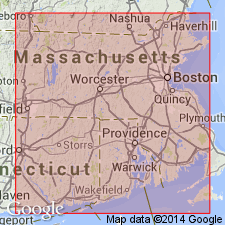
- Usage in publication:
-
- New London Gneiss
- Modifications:
-
- Overview
- Dominant lithology:
-
- Gneiss
- Amphibolite
- AAPG geologic province:
-
- New England province
Summary:
Usage of Waterford Group follows Goldsmith (1980; 1985). Described as a sequence of metavolcanic and metaplutonic plagioclase gneisses and amphibolites that unconformably overlies the Plainfield Formation in the Hope Valley terrane. (Hope Valley and Esmond-Dedham terranes compose the Avalon superterrane of this report.) Thickness of Waterford is variable; ranges to 3,100 m. Group subdivided (ascending) into Mamacoke Formation with its upper Cohanzie Member (first used?), New London Gneiss, and Rope Ferry Gneiss. New London consists of a layered facies and a massive facies. Layered facies described as alternating layers of light-colored biotite-quartz-plagioclase gneiss and amphibolite. Massive facies described as a granodiorite gneiss with a uniform texture, grain size, and color. Contains shiny black biotite plates and distinctive magnetite grains.
Source: GNU records (USGS DDS-6; Reston GNULEX).
For more information, please contact Nancy Stamm, Geologic Names Committee Secretary.
Asterisk (*) indicates published by U.S. Geological Survey authors.
"No current usage" (†) implies that a name has been abandoned or has fallen into disuse. Former usage and, if known, replacement name given in parentheses ( ).
Slash (/) indicates name conflicts with nomenclatural guidelines (CSN, 1933; ACSN, 1961, 1970; NACSN, 1983, 2005, 2021). May be explained within brackets ([ ]).

